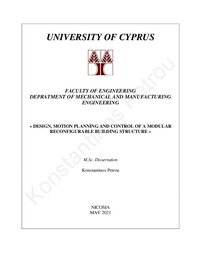Design, motion planning and control of a modular reconfigurable building structure

View/
Date
2021-05-28Author
Petrou, Konstantinos P.Publisher
Πανεπιστήμιο Κύπρου, Πολυτεχνική Σχολή / University of Cyprus, Faculty of EngineeringPlace of publication
CyprusGoogle Scholar check
Keyword(s):
Metadata
Show full item recordAbstract
The overall aim of the project is the design and control of a reconfigurable structure, achieving symmetrical and non-symmetrical forms with minimum actuation requirements. The structure is also required to provide flexibility in regard to motion planning and energy efficiency. Most buildings are designed as fixed-shape structures. During the design process future conditions and needs are uncertain and may change throughout use and time. Technological advances have enabled kinematics to be implemented and tested for reconfigurable structures, which can adjust their shape. Moreover, reconfigurability of structures establishes a framework that enables customization and optimization.
The research focuses on the design and control of a proposed multilink, articulated reconfigurable structure and the investigation of its morphological and kinematic behavior. Control is based on the dual ‘Effective Crank–Slider’ reconfiguration approach, namely a kinematics approach that reduces a planar system to 1-DOF system, through brakes on the system’s joints. Two actuation configurations are proposed related to a horizontal and a vertical motion. The structural body of the system consists of aluminum bars, connected via rotational joints and one slider associated with a linear actuator.
Initially, concepts and typologies of deployable and lightweight structures are discussed in comparison with the case of non-reconfigurable structures. Kinematics analysis focuses on the articulated system’s degrees-of-freedom to define the actuation requirements. The study also includes the analysis of the singular configurations of the mechanisms which impose constraints on motion planning and control. The analysis of the system starts from the selection of appropriate forms for the structure, the analysis of the construction design and proceeds to numerical studies. Main parameters that influence the design refer to the ground supports of each linkage, the members and their joint connections, as well as the actuation components that are integrated on the system. In motion planning the alternative reconfiguration sequences are generated and their feasibility is examined, also considering spatial constraints and singularities. Each sequence involves the selective application of joint brakes and a corresponding motion of the slider block via the linear actuator. Subsequently, the construction design of the proposed structure is presented and simulation studies provide the required brake torques and actuator effort. The methodology allows selecting an optimal sequence on the basis of different criteria (brake torques, required actuated joints motion, etc.).
An alternative actuation method is proposed based on specially-designed aerodynamic profiles installed on the proposed structure to exploit wind energy while realizing a reconfiguration. A system is designed that adjusts the orientation of the profiles according to the required control action. The feasibility of this concept is briefly examined by considering the wind conditions in different geographical locations.
The selection of an appropriate building shape can be on the basis of external conditions. The solar gain and lighting condition inside the building are factors that may drive reconfigurations. The analysis of the solar gain and lighting condition in relation to the motion of the sun will be investigated using software simulations in relation to the proposed reconfigurable structure and its reconfiguration capabilities.
